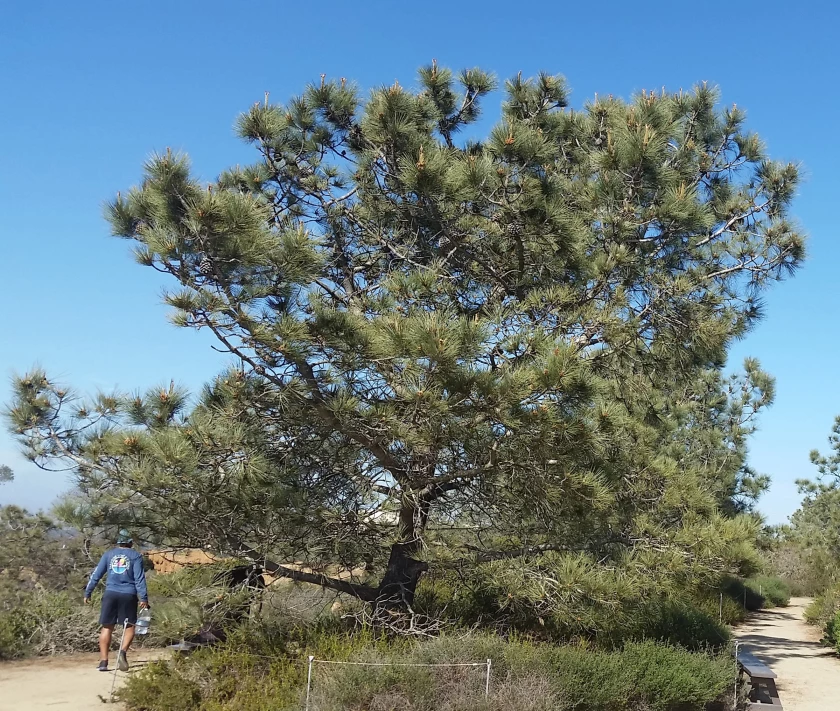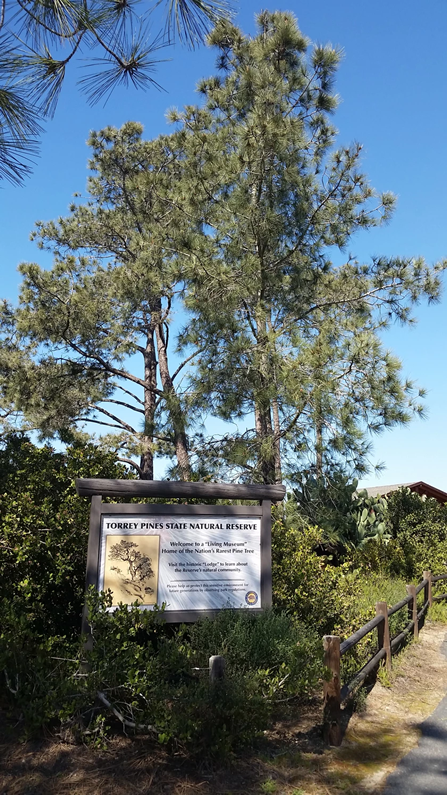Natural Reserve, San Diego Botanic Garden showcase rare species

The Torrey pine can only be found on the San Diego County mainland and on Santa Rosa Island.(James Huizenga)
BY HELEN MONTAG
(This article first appeared in the San Diego Union-Tribune June 2020)
In Southern California, there are two small remnants of “relic pine forests” that precede the most recent glacial period. Trees in these forests were well established on our southern coast long before offshore islands separated from the mainland. They are the Torrey pines, unique in all the world, in that they can only be found on the San Diego County mainland and on Santa Rosa Island, the second-largest of the Channel Islands.
Imagine that you are traveling with a group of botanists in the mid-19th century in Southern California on a survey expedition. It is 1850, and your group is observing everything about the physical world that surrounds you, including beautiful pine trees. Among them is the Torrey pine, already known to the Kumeyaay tribe and early settlers in the area for its piñon nut. The edible nut, although hard, is an important source of food for the Kumeyaay tribe.
One of the survey group members would have been Charles Christopher Parry (1823-90), the botanist considered to have “discovered” the Torrey pine. Parry officially named it Pinus torreyana after his friend and botanist colleague, John Torrey. Aside from the honor of naming a new species, we owe Parry our appreciation for his recognition that the Torrey pine was “endangered” as early as 1883. He wrote to the San Diego Society of Natural History about the need to protect the trees.
We also owe a debt of gratitude to San Diego visionary Ellen Browning Scripps, who, in the early 1900s, purchased the land where most of the trees stand. The area is now designated as Torrey Pines State Natural Reserve, and the pines continue to survive on the windblown, sandstone cliffs. Without her efforts, the Torrey pine might have disappeared forever.
The next time you see a Torrey pine, imagine that you are on that survey expedition, sent to examine the trees’ characteristics. Looking around, you notice a cluster of trees, medium-sized evergreen pines, with open spreading crowns on branches. You notice how they are leaning in various directions, with crowns sprawling to the leeward size. They are growing in a contorted manner because of exposure to the winds and salt spray from the ocean below.

Trees at Torrey Pines State Natural Reserve. The reserve remains closed during the pandemic.(James Huizenga)
The bark is deeply furrowed, brown and reddish. Many Torrey pines grow from rocky cliffs and outcroppings, putting down a long taproot and an elaborate root system. A Torrey pine that measures 40 feet high may have a 200-foot-long network of roots. The tree is usually found 600 to 800 feet above sea level on rocky or sandy slopes. It adapts easily to poor soil, withstands droughts and is dependent on the fog that comes in from the ocean. Those long and sculpted needles work to condense the fog into droplets that fall to the ground, providing additional moisture during the dry summer months.
Fast forward from the mid-19th century to today: Your daily routine has been turned upside down. You’ve been staying in place, avoiding crowds, washing your hands, wearing a mask and donning gloves. For months you’ve been thinking about all the things you miss. If you’re an outdoor enthusiast, you want to visit San Diego’s many beautiful gardens and nature trails. A few suggestions: Be sure to enjoy a visit to the San Diego Botanic Garden, where you’ll see a canopy of Torrey pines planted in the 1950s by landowners and residents Ruth and Charles Larabee. Also not to be missed is the Torrey Pines State Natural Reserve, where you’ll find trails that wind through old groves of Torrey pines and open up to spectacular ocean vistas with cactus and low sage scrub vegetation. This is San Diego at its park-visiting and nature-hiking best!
For up-to-date information on the opening of trails at Torrey Pines State Natural Reserve, go to: https://torreypine.org/home-2-2/reserveinfo/trails.
For up-to-date information on the opening of San Diego Botanic Garden, go to: sdbgarden.org.
Montag is an active UC Master Gardener who also enjoys history, genealogy and speaking Spanish.

